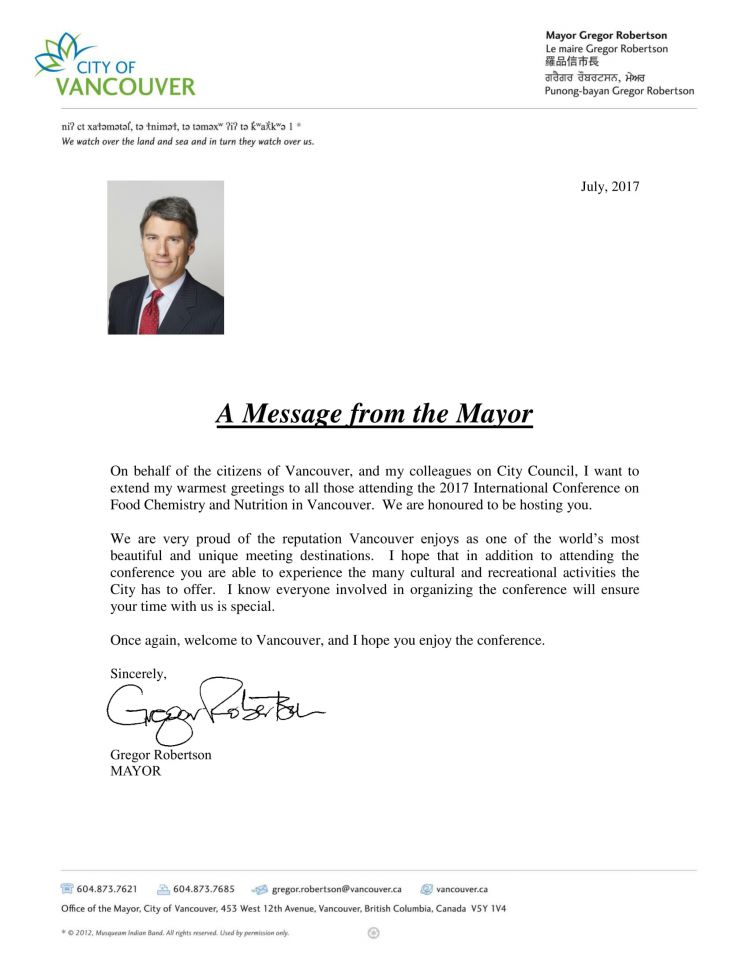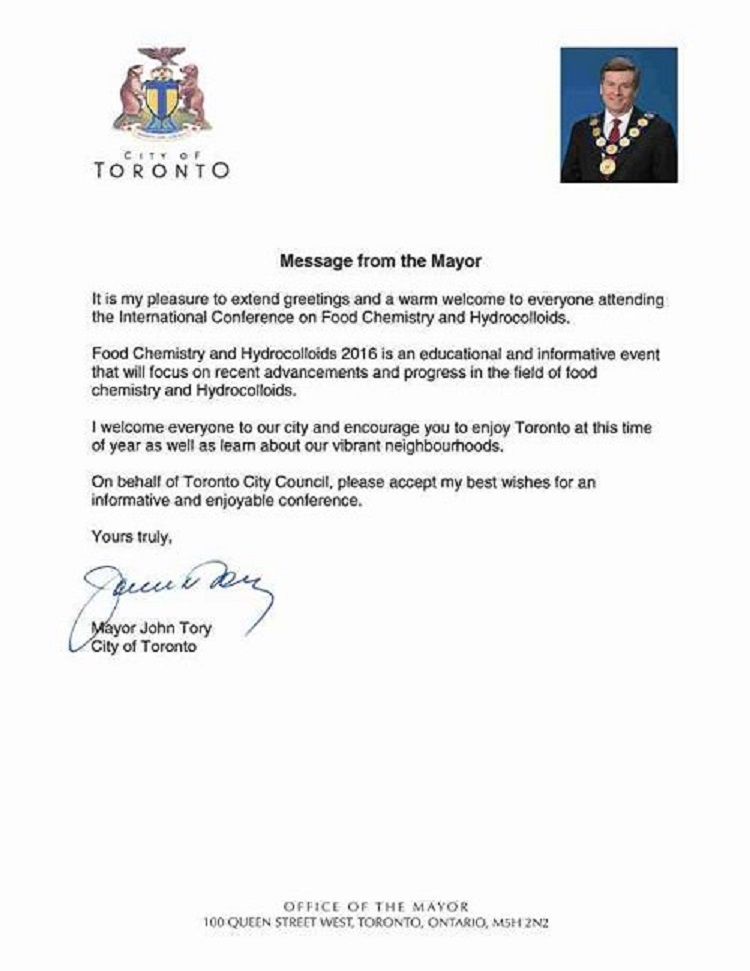Theme: Shaping the Future of Food Quality, Health & Safety
Food Chemistry 2018
- History of Food Chemistry
- About Conference
- Session & Tracks
- Market Analysis
- Vancouver Mayor Recognition
- Toronto Mayor Recognition
- Travel Guide

The history of food chemistry dates back to the late 1700s, when many famous chemists were involved in discovering chemicals important in foods. In 1813, Sir Humphry Davy published the first book on agricultural and food chemistry, in the United Kingdom. This book served as a foundation for the profession worldwide and went into a fifth edition. In 1874, the Society of Public Analysts was formed, with the aim of applying analytical methods to benefit the public. Its early experiments were based on bread, milk, and wine.
The development of colleges and universities worldwide, most notably in the United States, would expand food chemistry with research of the dietary substances, most notably the Single-grain experiment during 1907-1911. Additional research by Harvey W. Wiley at the United States Department of Agriculture during the late 19th century would play a key factor in the creation of the United States Food and Drug Administration in 1906. The American Chemical Society would establish their Agricultural and Food Chemistry Division in 1908 while the Institute of Food Technologists would establish their Food Chemistry Division in 1995.
Conference Series LLC Ltd successfully completed the first International Conference on Food Chemistry and Hydrocolloids during August 11-12, 2016 at Toronto, Ontario, Canada and 2nd International Conference on Food Chemistry & Nutrition during July 24-26, 2017 at Vancouver, Canada. With the successful completion of two annual conferences, Conference Series llc LTD is announcing the 3rd International Conference on Food Chemistry & Nutrition at Montreal, Canada during May 16-18, 2018.
Conference Series LLC Ltd organizes 2000+ Global Events inclusive of 1000+ Conferences, 600+ Workshops and 400+ symposiums on various topics of Science and Technology across the globe with support from 1000 more scientific societies and Publishes 750+ Open access journals which contains over 50000 eminent personalities, reputed Scientists as editorial board members. Conference Series LLC Ltd scientific events are the special designed cluster of program that provides a common platform where industry meets academia to discuss the recent issues and happening. It serve as a bridge between researchers from academia and industry enhanced by its well organized scientific sessions, plenary lectures, poster presentations, world class exhibitions, diverse symposiums, highly enriched workshops and B2B meetings.
This Food Chemistry 2018 conference will focus on the theme “Shaping the Future of Food Quality, Health & Safety”. So this is a valuable and important platform for inspiring international and interdisciplinary exchange of food and nutrition research. This food conference will focus on chemical components of food, their nutritional, sensory, flavour, microbiological and physiological aspects; changes in chemical and biochemical composition and structure during processing, transportation and storage; chemical aspect of food safety and quality, other by-products, and processing wastes; chemistry of agro-chemicals, food additives and contaminants, along with their metabolism and toxicology, etc.
The Conference will bring together academicians, chemists, scientists, dieticians, nutritionists, engineers, technologists from all over the world to exchange their knowledge and experience on food and nutrition research. We hope you will join us at Montreal, Canada for a fantastic networking experience.
Track-1: Chemical Composition of Foods
Food chemistry is the science that deals with the chemical composition and properties of food and the chemical changes it undergoes. Food composition data (FCD) are detailed sets of information on the nutritionally important components of foods and provide values for energy and nutrients including protein, carbohydrates, fat, vitamins and minerals and for other important food components such as fibre. The data are presented in food composition databases (FCDBs). Knowledge of the chemical composition of foods is the first essential in dietary treatment of disease or in any quantitative study of human nutrition.
Track-2: Chemistry of Food Constituents
Food chemistry also includes the study of chemical processes and interactions of all biological and non-biological components of foods. The biological substances include such items as meat, poultry, lettuce, beer, and milk as examples. It is similar to biochemistry in its main components such as carbohydrates, lipids, and protein, but it also includes areas such as water, vitamins, minerals, enzymes, food additives, flavors, and colors. This discipline also encompasses how products change under certain food processing techniques and ways either to enhance or to prevent them from happening. An example of enhancing a process would be to encourage fermentation of dairy products with microorganisms that convert lactose to lactic acid; an example of preventing a process would be stopping the browning on the surface of freshly cut Red Delicious apples using lemon juice or other acidulated water.
Track-3: Hydrocolloids in Food Industry
Hydrocolloids or gums are a diverse group of long chain polymers characterized by their property of forming viscous dispersions and/or gels when dispersed in water. These materials were first found in exudates from trees or bushes, extracts from plants or seaweeds, flours from seeds or grains, gummy slimes from fermentation processes, and many other natural products. Occurrence of a large number of hydroxyl groups noticeably increases their affinity for binding water molecules rendering them hydrophilic compounds. Further, they produce a dispersion, which is intermediate between a true solution and a suspension, and exhibits the properties of a colloid. Hydrocolloids have a wide array of functional properties in foods including; thickening, gelling, emulsifying, stabilization, coating and etc. Hydrocolloids have a profound impact on food properties when used at levels ranging from a few parts per million for carrageenan in heat-treated dairy products to high levels of acacia gum, starch or gelatin in jelly confectionery. The primary reason behind the ample use of hydrocolloids in foods is their ability to modify the rheology of food systems. This includes two basic properties of food systems that is, viscosity and texture. The modification of texture and/or viscosity of food systems helps modify its sensory properties, therefore hydrocolloids are used as significant food additives to perform specific purposes. It is evident that several hydrocolloids belong to the category of permitted food additive in many countries throughout the world. Various food formulations such as soups, gravies, salad dressings, sauces and toppings use hydrocolloids as additives to achieve the preferred viscosity and mouth feel. They are also used in many food products like icecreams, jams, jellies, gelled desserts, cakes and candies, to create the desired texture. In addition to the functional attributes, future acceptance and, possibly, positive endorsement may derive from the recognition that fibers contribute many physiological benefits to the natural function and well-being of the body.
Track-4: Rheology & Kinetics of Chemical Reaction in Food
Many reactions can alter food quality or safety. Each reaction class can involve different reactants or substrates depending on the specific food and the particular conditions for handling, processing, or storage. They are treated as reaction classes because the general nature of the substrates or reactants is similar for all foods. Thus, nonenzymic browning involves reaction of carbonyl compounds, which can arise from existing reducing sugars or from diverse reactions, such as oxidation of ascorbic acid, hydrolysis of starch, or oxidation of lipids. Oxidation may involve lipids, proteins, vitamins, or pigments, and more specifically, oxidation of lipids may involve triacylglycerol in one food or phospholipids in another.
Track-5: Food Preservatives and Packaging
Food preservation is to prevent the growth of microorganisms as well as slowing the oxidation of fats that cause rancidity. Food preservation may also include processes that inhibit visual deterioration, such as the enzymatic browning reaction in apples after they are cut during food preparation. Many processes designed to preserve food involve more than one food preservation method. Preserving fruit by turning it into jam, for example, involves boiling, sugaring and sealing within an airtight jar. Some traditional methods of preserving food have been shown to have a lower energy input and carbon footprint, when compared to modern methods. Some methods of food preservation are known to create carcinogens. Fermented meat is carcinogenic to humans. Damage or contamination by micro-organisms, air, moisture and toxins are protected by packaging, product spilling or leaking. Nutrition are prevented by packaging, ingredients and sell-by dates are important to the consumer and grocery stores as well. Food Packaging has been playing such an important role in the preservation and marketability of a product, many companies are seeking a contract packaging service to help them obtain the best quality packaging available. A co-manufacturer benefits by cost, speed, quality and innovation.
Track-6: Food Adulteration
Food adulteration is a legal term meaning that a food product fails to meet federal or state standards. Adulteration is an addition of another substance to a food item in order to increase the quantity of the food item in raw form or prepared form, which may result in the loss of actual quality of food item. These substances may be other available food items or non-food items. Among meat and meat products some of the items used to adulterate are water or ice, carcasses, or carcasses of animals other than the animal meant to be consumed. It not only includes the intentional addition or substitution of the substances but biological and chemical contamination during the period of growth, storage, processing, transport and distribution of the food products, is also responsible for the lowering or degradation of the quality of food products. Adulterants are those substances which are used for making the food products unsafe for human consumption. Under the previous food laws any food product with lowered or degraded quality used to be defined as adulterated food but under the new laws (FSS Act, 2006), the word adulterated food has been termed as Substandard Food, Unsafe Food or Food containing the extraneous matter.
Track-7: Regulatory Control of Food Composition, Quality, and Safety
It is essential to reiterate that safety is the first requisite of any food. In a broad sense, this means a food must be free of any harmful chemical or microbial contaminant at the time of its consumption. For operational purposes this definition takes on a more applied form. In the canning industry, commercial sterility as applied to low-acid foods means the absence of viable spores of Clostridium botulinum. This in turn can be translated into a specific set of heating conditions for a specific product in a specific package. Given these heating requirements, one can then select specific time-temperature conditions that will optimize retention of quality attributes. Similarly, in a product such as peanut butter, operational safety can be regarded primarily as the absence of aflatoxins—carcinogenic substances produced by certain species of molds. Steps taken to prevent growth of the mold in question may or may not interfere with retention of some other quality attribute; nevertheless, conditions producing a safe product must be employed.
Track-8: Nutrition and Functional Foods
Nutrient requirements for optimum health and function of aging physiological systems are often quite distinct from those required for young people. The special nutrition problems of the aged are intensively researched and tested, especially as the elderly become a larger percentage of the population. Many chronic diseases and cancers are found with higher frequency in the aged, and it is also widely known that many elderly people use foods and nutrients well above the recommended daily allowance, which can be detrimental to optimal health. Functional foods deliver additional or enhanced benefits over and above their basic nutritional value. Some functional foods are generated around a particular functional ingredient, for example foods containing probiotics, prebiotics and sterols. Other functional foods or drinks can be foods fortified with a nutrient that would not usually be present to any great extent. Functional foods and drinks may provide benefits in health terms, but should not be seen as an alternative to a varied and balanced diet and a healthy lifestyle. Functional foods are fortified or enriched during processing and then marketed as providing some benefit to consumers. Sometimes, additional complementary nutrients are added, such as vitamin D to milk. Health Canada defines functional foods as “ordinary food that has components or ingredients added to give it a specific medical or physiological benefit, other than a purely nutritional effect.” In Japan, all functional foods must meet three established requirements: foods should be present in their naturally occurring form, rather than a capsule, tablet, or powder; consumed in the diet as often as daily; and should regulate a biological process in hopes of preventing or controlling disease.
Track-9: Nutritional Disorder Management
Nutritional disorders can happen just due to less intake of proper food or certain nutrients or by an incapacity of the body to absorb and utilize nutrients, or by overconsumption of different types of foods”. Nutritional disorders can be particularly serious in any age of an individual, since they interfere with growth and development, and may predispose to many health problems, such as infections and chronic diseases. A metabolic disorder occurs when the metabolism process fails and allows the body to have either too much or too little of the essential substances needed to stay healthy. Our bodies are very sensitive to errors in metabolic activity. The body must have amino acids and many different types of proteins to perform all of its metabolic functions. For example, the brain and other parts of the body need calcium, potassium and sodium to generate electrical impulses, and lipids (fats and oils) to maintain a healthy nervous system.
Track-10: Nutraceuticals and Dietary Supplements
Nutraceuticals are the pharmaceutical-grade and standardized nutrients. In the US, nutraceuticals do not exist as a regulatory category; they are regulated as dietary supplements and food additives by the FDA under the authority of the Federal Food, Drug, and Cosmetic Act. A market research report produced in 2012 projected that the worldwide nutraceuticals market would reach US$250 billion by 2018, defining that market as Dietary Supplements, and Functional Foods & Beverages. A dietary supplement is a product that contains nutrients derived from food products that are concentrated in liquid or capsule form. In the US, the Dietary Supplement Health and Education Act (DSHEA) of 1994 defined the term: A dietary supplement is a product taken by mouth that contains a dietary ingredient intended to supplement the diet. The dietary ingredients in these products may include: vitamins, minerals, herbs or other botanicals, amino acids, and substances such as enzymes, organ tissues, glandulars, and metabolites. Dietary supplements can also be extracts or concentrates, and may be found in many forms such as tablets, capsules, softgels, gelcaps, liquids, or powders.
Track-11: Current Research in Food Chemistry, Nutrition and Dietetics
Track-12: Food Waste and Recycling
Food waste that is sent to landfill doesn’t harmlessly breakdown. It has a big impact on the environment as it rots and releases methane – a harmful greenhouse gas that is 25 times more potent than carbon dioxide. However, it’s not all bad news as many of us will be able to recycle our food waste. Food waste – such as fruit & veg peelings, egg shells and used teabags – can be turned into something useful. When recycled, it’s taken to a processing facility where it is turned into electricity to power your local community. Food waste can be recycled into useful resources with organics recycling. There are two main processes used to recycle food waste; In-vessel composting (IVC) and Anaerobic digestion (AD).
Track-13: Food Nanotechnology
Nanotechnology is having an impact on several aspects of food science, from how food is grown to how it is packaged. Companies are developing nanomaterials that will make a difference not only in the taste of food, but also in food safety, and the health benefits that food delivers. Clay nanocomposites are being used to provide an impermeable barrier to gasses such as oxygen or carbon dioxide in lightweight bottles, cartons and packaging films. Storage bins are being produced with silver nanoparticles embedded in the plastic. The silver nanoparticles kill bacteria from any material that was previously stored in the bins, minimizing health risks from harmful bacteria.
The study of chemistry probably dates from the first millennium AD and the route to modern food chemistry can be traced through the alchemist philosophies of medieval China, India and Europe, although it took about a thousand years for chemistry to grow into a coherent and inclusive discipline. The marriage of chemistry and biology led to many progeny, including agricultural chemistry, biological chemistry, food chemistry, industrial chemistry and pharmaceutical chemistry.
Food Chemistry is an overview of chemistry related to food sciences, such as food analysis, microbiology, nutrition, and food engineering etc. Food chemistry deals with food and Sustenance. Now there are some emerging new trends in college education.There is increasing emphasis on improving learning and teaching (L&T) quality, measuring student based learning outcomes, and improving core competencies. Teaching loads for most faculties are increasing. All this points to a need for better efficiency. Perhaps through improved study skills, better teaching methods, and increased distance learning. After decades of teaching food chemistry it is noticeable that these trends bring with them constraints and challenges for the students, Researchers, Industrialists.
WHY CANADA?
Qualifications Valued Around the World
Canada’s high academic standards and rigorous quality controls mean that you’ll be earning a high-quality education that will open doors for your future and benefit your career over the long term. A Canadian degree, diploma or certificate is globally recognized.
Multicultural Society
With almost all of the world’s ethnic groups represented in Canada, it’s hard not to find ethnic foods and recreation activities associated with specific cultures. Student get in touch with number of ethnic clubs and associations related to Scientific Trades.
Since research is one of the key components of a Canadian post-secondary education,one have ample opportunity to become a part of this vibrant aspect of education. In Canada, government and industry together support research including: telecommunications, medicine, agriculture, computer technology, and environmental science.
Land of Possibilities
Under Canada’s highly dynamic and hands-on academic environment, Canada has become examples of excellence, innovation, and beauty, all of which—along with top-notch educational institutions—make Canada one of the leading study abroad destinations in the world. Canada is one of the study destinations which holds International reputation for educational standards. The country spends more on education (as a percentage of GDP) compared to the OECD average, and is the second highest among G-8 countries. Canada boasts a wide range of quality educational institutions for both degrees and diplomas in technical and professional disciplines. Over 1, 30,000 international students attend Canadian colleges and universities. Canada holds high international reputation for educational standard. The cost of living in Canada is lower than countries like Australia, England or the United States. Canada also offers post study work options to the eligible applicants.
Canadian Universities
Canadian universities are known for being consistently high quality and for offering internationally accepted degrees and credentials; some are ranked in the top 100 by reputable sources as The Times Higher Education Supplement and Shanghai Jiao Tong University’s Academic Ranking of World Universities.
Over 10,000 undergraduate and graduate degree programs are offered at more than 100 institutions nationwide—and, tuition is generally much lower than in other leading study abroad countries. Students can pursue their studies at one of Canada’s top universities for roughly half of what it would cost to attend an equally reputable program at a private US university.
International students can expect to be assisted in their university studies by such resources and services as orientation sessions, support programs, academic advising, prayer rooms, safe walk programs, student clubs, and assistance with medical concerns or housing issues.
International students can often work while they study, taking advantage of many cooperative education and internship opportunities. There are also immigration programs that international students may qualify for post-graduation.
The high quality of Canadian university education is further enabled by membership in the Association of Universities and Colleges of Canada (AUCC) and provincial government charters.
Conference City
Montreal's food and beverage cluster is of great importance to the region, and along with Chicago, New York and Los Angeles, is one of the largest food and beverage clusters on the continent.
Why to Attend this Conference?
Educational opportunities: No matter how experienced you are at your business, everyone can learn. Working in research projects or business venture one can often be isolating, and without exposure to a variety of points of view, we can miss new ideas and trends that can impact future results. The educational aspect this conference can expose you to new ways of conducting your business and help you discover how to be more productive.
Networking with peers: Food Chemistry 2018 conference will provide a great opportunity to network. Often competitors from other regions of the country can become valuable resources for referrals and best-practices. Avoiding peers for fear of others discovering your competitive advantage can actually limit your own success. Collaboration is the way to approach networking. While there are those whose intentions can be suspect, most people can help each other uncover ideas and spark inspiration when they get to know each other on a personal level.
Expand your Business: Food Chemistry 2018 is a place where you can learn more about the current business climate. Discovering innovative products and services for your business is necessary to stay competitive in today’s fast-paced world. Plus, these vendors who sell to your industry fully grasp what is happening inside your competition. Invest time with the sponsors at the event and turn them into your friends and allies.
Position yourself as an expert. When you are active in your research and industry, you can develop a reputation as an expert to your peers and your clients. Those who are engaged over the long term are often asked to speak at the events and to write articles for their publications. Like it or not, others like to associate with the experts in any field. Clients feel good about doing business with those that are celebrated by their peers. If your strategy is to be the best-kept secret in your business community and research area, you will be missing a valuable opportunity.
Have fun. Being in research or business should be rewarding and fun. All work and no play can get old fast. Food Chemistry 2018 conference can add a layer of enjoyment to managing your career growth by mixing a social aspect into your learning and industry branding efforts. Here we are to share our beautiful city, a destination where you can unwind and enjoy yourself as Montreal offers a premier locale situated in Southern Ontario on the north western shore of Lake Ontario near local shopping malls and is just a few miles from downtown parks, moreover August in the city does not disappoint, with major events every weekend. Taking an extra day at the beginning or end of the trip to explore or visit friends in the region is also a great way to maximize the investment in travel. Never underestimate the power of a little fun mixed with some interesting people!
Benefits of Food Chemistry 2018 conference
· Learn about the latest research in your field
· Grow as a researcher and presenter
· Obtain feedback on your research
· Meet and get to know your peers
· Gain visibility in your field
· Share your research findings with others in your field
· Regroup and rethink
· Stay on top of trends and topics
· Promote Creativity & Innovation in business field
Market Research
Canadian Dairy Research
There are a total of 23 research projects involving more than 100 scientists, from 15 institutions and 8 government research centres across the country. Some of the nation’s best dairy scientists trains more than 65 graduate students and post-doctoral fellows. The overall objective of this kind of program is to promote the efficiency and sustainability of Canadian dairy farms, grow markets and supply high quality, safe and nutritious dairy products to Canadians.
Share of Non-Alcoholic Beverage Market by Volume (CANADA)
The majority of tea and coffee processing takes place in Ontario (41 establishments), Quebec (34 establishments) and British Columbia (26 establishments), followed by Alberta (9 establishments), Nova Scotia (3 establishments), Manitoba (2 establishments), and New Brunswick (2 establishments). Statistics Canada's Business Patterns Database indicates that in 2008 production facilities ranged in size from small one- or two-person operations to large plants employing up to 500 people. Four of the six major coffee and tea manufacturers (sales over $100 million) are foreign-owned.
There is a strong multinational presence in the coffee industry with some firms offering both tea and coffee products. Multinational enterprises (MNEs) have contributed to the growth of both imports and exports as their Canadian plants have focussed on areas where they have competitive advantages on a regional basis in both the U.S. and Canadian markets or in production flexibility. Canadian plants produce commonly known brands for the Canadian or North American markets, while benefitting from the marketing strengths of their parent MNE firms. They often have product mandates for "mainstream" products, as well as for value-added short-run production of less popular lines. Such mandates can build exports. At the same time, the need to fill product offerings in the Canadian market can increase imports.
Similarly, many small and medium-sized enterprises (SMEs) have rationalized and focussed their operations to remain competitive. These strategies involve the development of specialty products for market niches, such as organic or fairly traded products. In some cases SMEs also co-pack brand name products for MNEs, produce private-label products, or make products for use by foodservice operations such as coffee-themed restaurants.
Employment in Food sectors in Canada
The food processing sector is one of the largest manufacturing sectors in Ontario and in Canada. Toronto is a major decision-making centre for the food industry in Canada, with half of Canada's top ranked food and beverage manufacturers being headquartered in the city.
The food and beverage cluster has long been a major component of Toronto CMA's economy. It is the second largest manufacturing sub-sector in the Toronto CMA. The 1,149 employment establishments located in the Toronto CMA employ more than 51,000 people. Employment in this sector has increased at a rate of 0.4% annually during 2003-2013.
Organisations funding food research and food industries:
Ashoka Innovators for the Public (United States/International) – Ashoka supports a network of 3,000 social entrepreneurs across the world. By providing financing and start-up capital, Ashoka has been transforming the landscape of social innovation since 1980. It is encouraging fundamental transformation of the food chain to full nutrition with an initiative linking human wellbeing, agriculture, and the environment.
Australian International Food Security Centre (AIFSC) (Australia) – The AIFSC is a non-profit organization that works to promote agricultural innovation and attract investment to agricultural development projects. Aiming to build capacity for farming initiatives worldwide, AIFSC focuses on achieving specific goals like improving nutrition, connecting researchers with industry, and enhancing supply chain systems to allow farmers to bring their products to market.
Barilla Center for Food & Nutrition (BCFN) (Italy) – The Barilla Center for Food & Nutrition works to promote science and research for combating hunger and malnutrition worldwide. Using knowledge gleaned from research projects around the world, BCFN seeks to take innovative ideas for tackling food insecurity and translate them into effective policy recommendations for governments around the world. Since their inception, they have released original research on a wide range of topics including global obesity and sustainable agriculture.
Bioversity International (International) – Bioversity International is a research and development organization aimed at supporting smallholder farmers in the developing world through sustainable agriculture and conservation. Bioversity International focuses on rain-fed farming systems, managed by smallholder farmers, in communities where large scale agriculture is not possible.
Calacea Farm, Not For Sale (NFS) (Romania) - NFS is an organization working to fight modern-day slavery around the world. In Romania, NFS works with their partner Mariana, operating an organic farm, which accommodates survivors of human trafficking. Just outside Timișoara, the farm offers individuals in recovery opportunities for health care, education, life skill training and new employment, to restore dignity and help re-build their future. Last year, NFS helped construct a building to house up to 50 additional farm workers, a workshop space to make jam, milk, and cheese, and two greenhouses to produce fruits and vegetables.
Center for Food Safety (United States) - The Center for Food Safety is a non-profit advocacy organization that promotes food systems that are safe, sustainable, and environmentally sound. Using a legal team, original research on agriculture, and grassroots organizing, CFS’ mission is to protect human health and the environment, achieved through careful monitoring of the agricultural industry for violations of food safety and environmental laws.
The Center for Studies and Development of Cambodian Agriculture (CEDAC) (Cambodia) - In partnership with Farmer and Nature Net (FNN), CEDAC has worked to promote the System of Rice Intensification (SRI), which has been shown to increase yields and improve soil fertility while reducing the use of chemicals and maintaining local ownership of seeds. CEDAC supports several other agricultural innovations and techniques including Ecological Chicken Raising (ECR), pig raising, home gardening, aquaculture, composting, and multi-purpose farming.
Chicago Council on Global Affairs Global Agricultural Development Initiative (United States/International) - The Global Agricultural Development Initiative seeks to inform the development of U.S. policy on global agricultural development and food security by raising awareness and providing resources, information, and policy analysis to the U.S. Administration, Congress, and interested experts and organizations.
Christensen Fund (United States) – The Christensen Fund is a philanthropic organization dedicated to promoting biological and cultural diversity, making grants to organizations that work in fields like conservation science, visual arts, and education. The Fund is particularly noted for its work on agrobiodiversity and food sovereignty, in which it provides resources for indigenous and local farming communities to protect and enhance local food systems.
Consultative Group on International Agricultural Research (CGIAR) (International) - The Consultative Group on International Agricultural Research is a network of research organizations that are looking to promote and support global food security. With 15 centers around the globe, CGIAR helps to share knowledge and advance research on rural poverty, health and nutrition, and management of natural resources.
EARTH University (Costa Rica) – EARTH University is an international non-profit undergraduate institution based in Costa Rica focused on agricultural sciences and natural resource management. EARTH’s mission is to “prepare leaders with ethical values to contribute to the sustainable development of the tropics and to construct a prosperous and just society.”
Ecoagriculture Partners (United States/International) – Ecoagriculture Partners supports agricultural communities in managing their landscapes by using ecoagriculture in order to enhance rural livelihoods, conserve biodiversity, and produce food and fiber in environmentally sustainable ways.
ECOVA MALI (Mali) – Founded by former Peace Corps volunteers, Cynthia Hellmann and Gregory Flatt, ECOVA MALI works with Malian farmers to teach other farmers about sustainable agriculture methods. They also offer micro-financing and small-scale grants so that farmers can invest in the sustainability, both social and environmental, of their operations.
Farm Labor Organizing Committee (United States) – Founded in 1967, FLOC was initially organized by Baldemar Velasquez, a migrant worker who sought to improve the working conditions of others like him by creating a mobile organizing base that could move along with workers as the seasons changed. Now, FLOC has over 20,000 members and works in both the United States and Mexico.
Feeding the 5000 (United Kingdom/International) – Tristram Stuart’s initiative is organizing the world to prevent "wonky" fruits, vegetables, and other food from being wasted. Feeding the 5000 encourages farmers to participate in the “gleaning movement” – where volunteers collect unattractive produce that would otherwise be wasted for consumption.
Food & Water Watch (United States) - Founded on the belief that people have a fundamental right to trust the safety of the products they eat and drink, Food and Water Watch is a nonprofit organization that works to make food and water resources accessible and sustainable. They work to monitor food production and clean water systems, track the environmental quality of oceans, keep watch over U.S. corporate influence on public policy, and hold policymakers accountable for policies that pollute.
Food First: The Institute for Food and Development Policy (United States/International) - Food First is a research and advocacy organization that seeks to eliminate the injustices that cause hunger worldwide, working with social movements to amplify their voices and boost their efforts toward food justice and sovereignty. Believing that change happens from the ground up, Food First supports an agricultural approach that moves away from transnational agri-food industry to one focused primarily on farmers and communities.
Food Mythbusters (United States) – Food Mythbusters is a campaign of the Real Food Media Project that seeks to dispel misconceptions about food production and promote reforms in industrial agriculture, unfair labor practices, and food advertising, among other issues. In order to tell “the real story of our food,” Food Mythbusters utilizes video series, grassroots events, and interactive digital content.
Global Partnerships for Afghanistan (GPFA) (Afghanistan) – GFPA launched the Women Working Together collaborative initiative in 2005 in order to increase the quality of life of women in Afghanistan. GPFA focuses on programming that enhances female-run farms and orchards, teaching food preservation, greenhouse operation, and other practices.
Good Planet Foundation (France) – The GoodPlanet Foundation seeks to educate the public about the importance of environmental protection. The organization utilizes the power of photographs, posters, websites, films, and other visual media to spread information. For example, GoodPlanet has lead successful campaigns on the awareness of ocean and forest conservation, respectively.
Growing Power (United States) – Growing Power, Inc. is an American non-profit organization and land trust that seeks “to grow food, minds, and community” through a network of farms, training sites, and community food systems that provide access to food for all people. Growing Power also runs a number of youth programs and collaborates with various organizations, including Michelle Obama’s “Let’s Move!” campaign. This year, Growing Power celebrates its 20th anniversary.
Heifer International (United States/International) - Heifer International is a non-profit organization that seeks to end hunger and poverty by providing communities in need with livestock and other animals that help them to build local, self-sufficient agricultural systems. It also offers a variety of resources that help impoverished farmers create sustainable sources of income, providing them with research on effective grazing methods, optimal animal well-being, and the creation of local networks that farmers can use to share resources with one another.
Institute for Agriculture and Trade Policy (IATP) (United States/International) – IATP is a research and advocacy organization working to promote fair and sustainable food, farm, and trade systems around the world. Created in response to the American family farm crisis, IATP initially sought to document the failed policies that had led to prices dropping below the cost of production, and put many family farmers out of business. Now, IATP works with organizations worldwide to analyze the impact of global trade agreements, develop clean energy models, and stop the excessive use of antibiotics in agriculture and aquaculture.
International Fund for Agricultural Development (IFAD) (International) – This United Nations-supported financial institution is on a mission to eradicate rural poverty in developing countries. IFAD helps empower the rural poor by providing them with the resources they need to invest in themselves and increase their incomes.
L.I.F.E. (Lasting Impact for Ethiopia) (Ethiopia) – This nonprofit organization is educating and empowering Ethiopian youth. In January 2012, a school for Ethiopian youth was established in the village of Nazerate, with a curriculum emphasizing literacy, agriculture, health, and sustainability.
Latin American and Caribbean Center for Rural Women (Enlac) (Latin American and Caribbean Regions) – The Latin American and Caribbean Center for Rural Women (Enlac in Spanish) serves as an organizing voice for marginalized, rural women. Enlac calls for policies that give Latin American and Caribbean women equal access to land rights, raise awareness about violence against female agriculture workers, boost access to clean water, and conserve native seeds.
Millennium Institute (MI) (United States/International) – Millennium Institute is an independent nonprofit with the goal of promoting systems literacy and dynamic modeling tools in order to achieve sustainable development globally. MI works to achieve awareness through public education and strategic partnerships centered around interdependence and sustainability.
One Acre Fund (United States/Sub-Saharan Africa) – The One Acre Fund provides farmers in sub-Saharan Africa with the tools they need to successfully operate their plots, such as seeds and fertilizers, credit, access to markets, and educational programs on farming techniques. These services are provided at a fee to the farmers who participate.
ONE Campaign (International) – The ONE Campaign is an international advocacy group aimed at alleviating extreme poverty and preventable disease through public awareness.
Oxfam International (International) – Through a wide variety of approaches – ranging from long-term campaigns, such as their Behind the Brands Campaign to secure labor rights for employees in the cocoa industry, to immediate emergency support – Oxfam has taken measures to bring an end to global poverty.
Restaurant Opportunities Centers United (ROC-United) (United States) –ROC-United is a labor advocacy organization that focuses specifically on the American restaurant workforce. Founded by restaurant workers who survived the 9/11 attacks to help other displaced workers, ROC-United primarily advocates for better wages and working conditions, seeking to act as a champion for members of an industry that is less than one percent unionized.
The Savory Institute (United States/International) – This organization, lead by Allan Savory, the “father of holistic management,” uses livestock in sustainable ways to restore grasslands. The Savory Institute teams up with private investors to purchase ranch real estate for restoration.
Slow Food International (Italy/International) - Slow Food International is an international non-profit organization with supporters in 150 countries that emphasizes the importance of good food and the factors that make it possible, including biodiversity, culture, and knowledge. Created to respond to an increasingly “fast food” world, Slow Food seeks to preserve local traditions, enhance people’s understanding of food and where it comes from, and comprehend the impact that our food choices make on the world.
Soil Association (United Kingdom) – The Soil Association is a U.K.-based charity that campaigns for humane and healthful food through sustainable farming and land use. Founded in 1946, Soil Association was an early player in the movement to identify links between farming practices and the health of humans, plants, animals, and ecosystems. Now, the organization works closely with communities to create and inspire trust in organic farming methods and the food that they produce.
Ministry of Food Processing Industries, INDIA-The Ministry of Food Processing Industries, the Nodal Ministry of the Government of India for the sector has a clear goal of attaining these objectives by facilitating and acting as a catalyst to attract quality investments from within India and abroad into this sector with the aim of making food processing a national initiative.
Budget Allocation: 487 crore
Songtaab-Yalgré Association (SYA) (Burkina Faso) - SYA brings together women from across Burkina Faso to produce shea nuts, using the collective to simultaneously improve their literacy and their working conditions. As a locally-sourced crop, shea nuts were chosen for their potential to allow the women harvesting them to achieve a higher level of economic self-sufficiency, and empower them to become independent in their society. Workers at SYA distribute profits equally and set aside a percentage to fund community development projects as well.
Stone Barns Center for Food and Agriculture (United States) – The Stone Barns Center is a non-profit organization that aims to create a food system that is healthy, sustainable, and which benefits all people. On an 80-acre farm just outside of New York City, the Center offers cooking classes for all ages, organizes a seasonal market, and operates two food venues. All profits support farm operations and community education programs, and the Center encourages anyone to visit and see the benefits of a sustainable farm.
United Nations Food and Agriculture Organization (FAO) (International) – The Food and Agriculture Organization is the United Nations’ international agency overseeing global food security and agriculture. Among their many research areas, FAO’s main activities include knowledge-sharing among member nations, making information about food and agriculture available for all people, supporting policies to reduce malnutrition and other illnesses worldwide, rallying the international community to promote effective strategies for agricultural development, and conducting research to better understand the complex issues that face the global food system.
WinRock (United States/International) – WinRock works with marginalized people all over the world to provide them with the skills and resources they need to bring themselves out of poverty. WinRock’s projects include, among others, empowering women and youth, and teaching environmentally responsible farming methods.
World Food Programme (WFP) (International) – The World Food Programme is an international anti-hunger organization within the United Nations that collects and distributes food assistance to populations in need. As the world’s largest organization working to combat hunger, WFP distributes food to over 90 million people annually, mainly delivering assistance to children, refugees, people in emergency situations (such as the 2010 earthquake in Haiti) and the rural poor.
World Vegetable Center (AVRDC) (Taiwan/International) – AVRDC is an international non-profit organization dedicated to reducing poverty and malnutrition in the developing world by increasing agricultural production and access to a variety of vegetables, providing essential micronutrients for populations in need. The Center works with both private and public sector partners to strike an effective balance between necessary research for new technologies and development to employ those technologies effectively.
Universities offering Food science study in Canada
Alberta University
British Columbia University
Greater Vancouver University
Manitoba University
Newfoundland University
Nova Scotia University
Ontario University
Quebec University
Saskatchewan University
Graduate University
Canada University
Alberta University
British Columbia University
Greater Vancouver University
Newfoundland University
Nova Scotia University
Ontario University
Quebec University
Canadian Food sector leaders
Maple Leaf Foods Inc.
Campbell Soup Company Limited
Cargill Limited
Fiera Foods Company
George Weston Limited
Kraft Canada Inc.
Unilever Canada Limited
Wrigley Canada
Olymel
Red Deer
Cornwall
Lakeside Packers
Lilydale Foods
Olymel
Sunrise Poultry
McCain Foods Limited
George Weston Limited
Saputo Inc.
La Coop fédérée
Molson Canada
Nestlé Canada Inc.
Cott Corporation
Parmalat Dairy & Bakery Inc.
Agropur Cooperative Agro-Alimentaire
Pepsi-QTG Canada
General Mills Canada Corporation
FPI Limited
Export Packers Company Limited
Campbell Company of Canada
Lilydale Co-operative Limited
Maple Lodge Farms Ltd.
Vincor International Inc.
SunOpta Inc.
Breton Foods Canada Inc.
Barry Callebaut Canada Inc.
Clearwater Seafoods Limited Partnership
Gay Lea Foods Co-operative Ltd.
Van Houtte Inc.
Carriere Foods Inc.
Regional classification:
Based on regions the market is segmented as North America, Europe, Asia-pacific, South America and Africa. In 2013, North America was the largest market for hydrocolloids followed by Europe. Asia-Pacific is the fastest growing region followed by Europe for the period 2015-2020. Changing lifestyles of consumers and increasing awareness on nutritional food is driving the hydrocolloids market in developing countries, such as India and China.


Conference Venue Details: http://foodchemistry.conferenceseries.com/venue-hospitality.php
Find out what you need to visit Canada as a tourist or business person, how to extend your stay in Canada and what documents you need to carry with you to transit through Canada.
Application submission:
Canada does not have a visa office in every country so it is important that Delegates/Attendees visit the website of the visa office responsible for processing their visa applications. Information is available on the website on how to submit a visa application and the documentation required.
Delegates/Attendees are encouraged to submit their visa applications well in advance of the date of the event at a Visa Application Centre or on-line E-applications (e-Apps).
E-Apps
This system allows clients to submit applications online.
Delegates/Attendees that need a visa but require their passport for other travel purposes are strongly encouraged to submit their visa applications on-line (e-Apps). Delegates/Attendees that choose to apply on-line will not have to submit their passport until a decision has been taken on their applications. If required, the visa office will send the applicant instructions on how and where to send their passports to finalize the visa process.
Visa Application Centres (VACs):
VACs are commercial service providers authorized by Canada to provide specific services to applicants.
VACs provide a number of services including help applicants fill out forms, answer questions and ensure that applications are complete, thereby reducing unnecessary delays or refusals due to incomplete applications.
Applicants that are required to provide biometrics information as part of the visa application process can do so at a VAC. Additional information on the biometrics requirements is available at the IRCC website.
VACs send applications to Visa Offices and transmit decisions to applicants in a secure and confidential manner. VACs do not process visa applications and play no role in the decision-making process.
Visa Applications Processing Time:
Processing time for visa applications vary depending on the office and the time of the year. Participants should be encouraged to apply early for their visas, and to submit complete applications including all supporting documents.
Please visit the IRCC website for information on the time it takes to process visa applications at the various visa offices.
NEW - Electronic Travel Authorization (eTA)
As of March 15, 2016, visa-exempt foreign nationals are expected to have an Electronic Travel Authorization (eTA) to fly to or transit through Canada. Exceptions include U.S. citizens, and travellers with a valid Canadian visa. Canadian citizens, including dual citizens, and Canadian permanent residents are not eligible to apply for an eTA.
However, from March 15, 2016 until fall 2016, travellers who do not have an eTA can board their flight, as long as they have appropriate travel documents, such as a valid passport. During this time, border services officers can let travellers arriving without an eTA into the country, as long as they meet the other requirements to enter Canada. We invite you to consult the IRCC website regularly for information updates on eTA.
Conference Highlights
- Chemical Composition of Food
- Chemistry of Food Constituents
- Hydrocolloids in Food Industry
- Rheology and Kinetics of Chemical Reaction in Food
- Food Preservatives and Packaging
- Food Adulteration
- Regulatory Control of Food Composition, Quality, and Safety
- Nutrition and Functional Foods
- Nutritional Disorder Management
- Nutraceuticals and Dietary Supplements
- Current Research in Food Chemistry, Nutrition and Dietetics
- Food Waste and Recycling
- Food Nanotechnology
- Food Science and Technology
To share your views and research, please click here to register for the Conference.
To Collaborate Scientific Professionals around the World
| Conference Date | May 16-18, 2018 | ||
| Sponsors & Exhibitors |
|
||
| Speaker Opportunity Closed | Day 1 | Day 2 | Day 3 |
| Poster Opportunity Closed | Click Here to View | ||
Useful Links
Special Issues
All accepted abstracts will be published in respective Our International Journals.
- Journal of Experimental Food Chemistry
- Journal Food Processing & Technology
- Journal of Nutrition & Food Sciences
Abstracts will be provided with Digital Object Identifier by



























